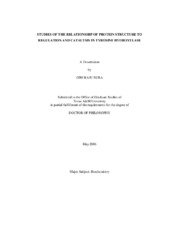| dc.description.abstract | Tyrosine hydroxylase (TyrH) catalyzes the rate-limiting step in the synthesis of the catecholamine neurotransmitters dopamine, epinephrine, and norepinephrine. Phosphorylation of Ser40 of rat TyrH activates the enzyme by decreasing the affinity for catecholamines. In humans, there are four different TyrH isoforms with varying lengths for the regulatory domain. DOPA and dopamine binding studies were performed on the phosphorylated and unphosphorylated human isoforms. The Kd for DOPA was increased two times upon phosphorylation of hTyrH1, but no change was seen for hTyrH4; the Kd value decreased with the increase in the size of regulatory domain. The small effect on the Kd value for DOPA upon phosphorylation of hTyrH suggests that DOPA does not regulate the activity of hTyrH. Dopamine binds very tightly and upon phosphorylation the affinity for dopamine is decreased. This Kd value decreases with the increase in the length of the regulatory domain. The crystal structures of substrate complexes of the homologous enzyme phenylalanine hydroxylase (PheH) show a large movement of a surface loop (residues 131-155) upon amino acid binding. The corresponding loop residues (175-200) in TyrH play an important role in DOPA formation. This conformational change in TyrH loop was studied with fluorescence anisotropy. Three tryptophan residues in the TyrH, at positions 166, 233, and 372, were mutated to phenylalanine, and Phe184 was mutated to tryptophan. An increase in anisotropy was observed in the presence of phenylalanine and 6-methyl-5-deazatetrahydropterin (6M5DPH4), but the magnitude of the change of anisotropy with 6M5DPH4 was greater than that with phenylalanine. Further characterization of the sole tryptophan in the loop showed a decrease in the amplitude of the local motion only in the presence of 6M5DPH4 alone. The conformational change in wild type TyrH was examined by H/D exchange LC/MS spectroscopy in the presence of the natural ligands. Time-course dependent deuterium incorporation into the loop in the presence of ligands indicated that the pterin alone can induce the conformational change in the loop irrespective of whether iron is reduced or oxidized. From these results, one can conclude that the loop undergoes a conformational change upon pterin binding, making the active site better for amino acid binding. | en |


